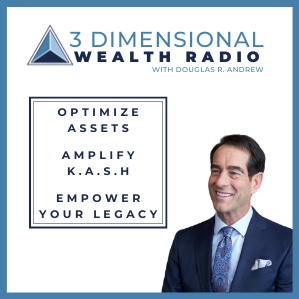Why you don’t want to live without indexing
At times like these when the stock market is like a daily roller coaster ride, protecting the money you’ve set aside for retirement can be absolutely critical. You’ve heard me talk a lot about the LASER Fund—it’s one of the safest financial vehicles that can actually help you sprint in the race toward retirement.
The LASER Fund is technically a properly structured, maximum-funded, tax-advantaged universal life insurance policy. What helps make it a superior retirement vehicle is the ability to employ indexing strategies with your LASER Fund. Indexing allows your money to be linked to the market, while not actually in the market. This lets you participate in most or all of the upside without taking on any downside risk.
IF YOU HAD $1 MILLION IN A LASER FUND
To illustrate, let’s say you have $1 million in a LASER Fund. You have several choices for which index you’ll choose—you can choose a single index or you can link your policy to a combination of them. In this case, you opt to link your policy entirely to the S&P 500. You also have options and choices when it comes to crediting methods and index allocations. The returns in these indices are typically calculated annual point-to-point (I’ll explain more on index choices and crediting methods in future articles).
Let’s say your policy has an anniversary date of December 31 (this could be any date—it is not based on calendar year but on the date your policy was issued). On December 31 of last year, the S&P was at 1,000. On December 31 of this year, the S&P saw an increase to 1,100 (a 10% increase). The insurance company is contractually obligated to pay you the yield, which is 10%. On $1 million, that means they will put $100,000 into your policy. That $100,000 is locked in as new principal.
Now, the following year, there’s a financial disaster, and the economy tanks. While most Americans invested directly IN the S&P could lose a significant amount (which millions of Americans did, losing as much as 40% in 2003 and 2008) … here’s the great part … you don’t.
With indexing, your principal is completely safeguarded from losses due to market volatility. What’s more, every year your index “resets” on your policy anniversary. Essentially, with your annual point-to-point crediting method, where the S&P 500 is on your anniversary date, that becomes the new set-point for the coming year.
SO HOW DOES INDEXING WORK?
Many people have asked how indexing works—how exactly can insurance companies give you all the upside benefits of the market while protecting you from the downsides?
Let’s take a look behind the scenes to see how indexing is possible.
Let’s say you have a LASER Fund with a cash value of $1 million. We’ll imagine that $1 million is in a “policy value bucket.” Each year, your insurer puts your money into its General Account Portfolio, with the lion’s share of that money in safe, conservative investments like AAA and AA bonds with typically stable rates of return. Let’s say this year, your insurer puts $950,000 into the GAP.
Now what about that other $50,000? They take $50,000 of your $1 million to buy options. You may be thinking, “Options … doesn’t that put that $50,000 at risk in the market?”
The answer is yes, it does. But remember the GAP portfolio? Your $1 million principal is guaranteed a 0% floor because the GAP will typically earn 3%-5% to cover that risk.
So even if the options lose money due to a market downturn, that loss of $50,000 doesn’t impact your principal at all.
But what if it gains? Then even better, you get to benefit from that gain. Let’s say the market goes up 10%. The $50,000 your insurer spent on options turns into $100,000—which means your $1 million of cash value earned 10%.
What if the market goes up 20%? The insurance company will only make up to 12.25% ($122,500) because of the way it manages options. This is why there is a cap of 12.25% on your policy in this scenario.
If the market goes down -40% like it did in 2008, the $50,000 in options is now worthless. That $50,000 may be lost, but you still have your principal of $1 million in cash value, because of the GAP. You don’t lose any money due to market volatility.
That 0% ground floor protection is why we say, “Zero is the hero.”
WHAT ABOUT CAPS?
Now you may be wondering, why do caps vary from year to year?
The insurance company sets the cap, based on variables like their options costs and the rate they’re earning on the GAP. If interest rates in America are going up and the GAP is set to earn more this year, they will likely put less (like $940,000) of your cash value into the GAP, put more (like $60,000) to work in options, and raise the cap slightly for the year—because they are likely to get stable returns in the GAP.
With some indexes, there are no caps. You may have been able to guess why: Because the costs on the options associated with this index are so low, the insurance company can afford to remove the cap.
INDEXING OPTIONS
You have a few important choices with your indexing options:
- Which index you’d like, based on those offered with the policy (insurance companies tend to offer some common indexes, as well as some they’ve designed exclusively for their policyholders)
- Which crediting method you’ll choose for your selected index
- Whether you’ll typically leave your choices as your “default” year-to-year, or you’ll change it annually (you can make changes to your index options on your anniversary every year)
I explain indexing even more in my book, The LASER Fund, so if you’re curious for a deeper dive, you can click here to get it!. Just know that especially in volatile times—but really at any time, indexing gives you an advantage you don’t want to live without.
Want to learn more about some of the concepts in this article? Watch these explainer videos on our YouTube Channel!
What’s The Best Strategy When The Market Crashes?
How Do I Not Lose Money I’ve Made?
What Do Wealthy People Do With Their Money?
Are you ready to see the nuts and bolts of a LASER Fund? Get your FREE copy of Doug’s book, The LASER Fund. You’ll learn how to protect your “serious cash” and how to eliminate taxes on your retirement nest egg.
Disclaimer: With any mention of The LASER Fund, maximum-funded tax-advantaged insurance contracts, or related financial vehicles, let it be noted that life insurance policies are not investments and, accordingly, should not be purchased as an investment. The content contained in this post is intended for general informational purposes only and is not meant to constitute legal, tax, accounting or investment advice. You should consult a qualified legal or tax professional regarding your specific situation. Many traditional retirement vehicles involve risk, and the value of your investment will fluctuate over time and you may gain or lose money.


